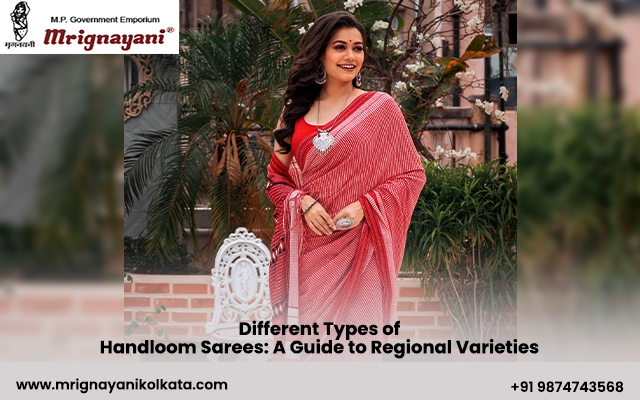Exploring the rich history of handloom sarees is akin to embarking on a journey through the diverse landscapes of India. Each region boasts unique weaving techniques, vibrant colour palettes, and distinctive motifs. Below, we delve into the origin and rich cultural significance of popular handloom sarees in Kolkata.
- Maheswari Saree: The exquisite Maheshwari saree traces its origins back to the 18th century in Madhya Pradesh, in the town of Maheshwar. The fabric of the saree is a blend of Coimbatore cotton and Bangalore silk yarns, featuring modern and graceful motifs like flowers, jasmine, swan, and diamond. The saree is adorned with a reversible border and distinctive five stripes on the pallu. The border has Zari thread works. These sarees are vibrant and are mostly available in shades of deep brown, golden yellow, and grape green.
- Chanderi Saree: In the 1930s, weavers in Madhya Pradesh discovered Japanese silk and started substituting the traditional cotton saree wrap with Japanese silk, giving birth to Chanderi sarees. Characterised by their sheer texture and lightweight feel, Chanderi sarees in Kolkata are celebrated for their timeless elegance. The golden thread detailing on these sarees adds a touch of luxury, making them a preferred choice for special occasions.
- Kosa Silk Saree: Originating in Chhattisgarh, particularly in the districts of Champa and Korba, Kosa silk fabric is renowned for its exceptional quality. Both Tussar and Kosa silk fall into the category of silk that is obtained from wild moths. The traditional designs of these silk sarees carry historical and symbolic significance. These designs include motifs such as Kumbha or temple motifs, kangaroos, and others inspired by nature, encompassing trees and flowers, scenes of cutting crops, fish, and peacocks. The rich cultural heritage reflected in these intricate patterns adds to the allure of Kosa silk.
- Bagh Print Saree: Bagh, a distinctive block printing technique, finds its roots in the quaint village of Bagh in Madhya Pradesh. Utilising finely cut wooden blocks and vegetable dyes, Bagh printing manifests as an array of vibrant floral and geometrical prints. Culturally and religiously significant to the tribal communities of Dhar, traditional Bagh prints, characterised by red, black, and white hues along with religious motifs, hold prominence in tribal festivals and special occasions such as marriages.
The rich tapestry of handloom sarees in Kolkata reflects the diversity and cultural vibrancy of each region. These sarees symbolise artistic excellence that has been passed down through generations, making them not just pieces of clothing but living embodiments of a region’s cultural heritage.

